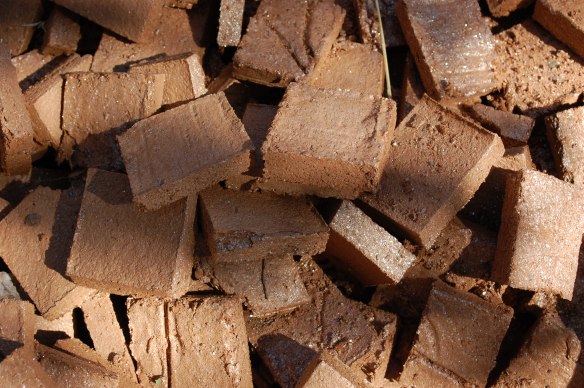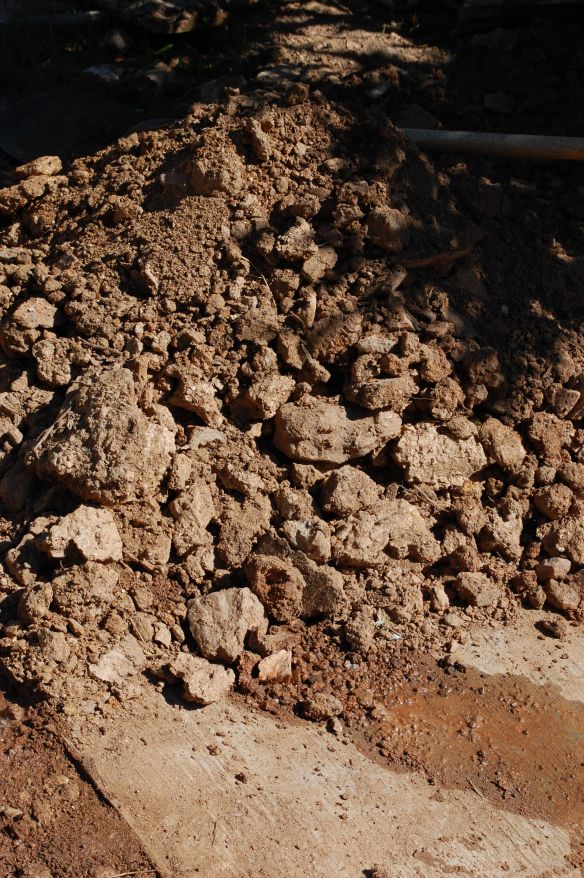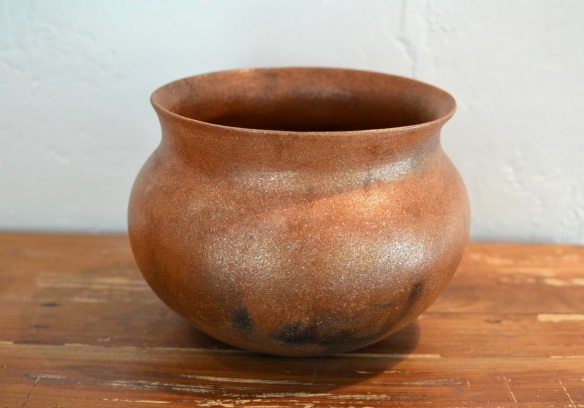The harvest and creation
My first experience with digging clay was in a little arroyo in Colorado. I was part of a small vessel-building class. With my shovel, I worked along the walls of the arroyo harvesting earth and hoping that by the end of the day I would have enough to make a small bowl. The earth I brought back did not resemble clay—it was a dry composite of loose dirt, rocks, twigs, insect carcasses and all sorts of organic matter. It seemed impossible that I would turn this into a vessel. As I kneaded my little ball of clay I felt I was on a timeless journey, an odyssey rooted in a faraway place that I had been before. Holding in my hand this generative clay from the land where I was born took me back to the moment of first breath, first seeing and smelling, first moment of being birthed. From this internal place I formed my little trinket bowl and beads. I thought, what a marvelous thing this is, to return to the beginning of things, to dig earth, make clay and birth form. I did not know at that time that I would go on to explore clay in the traditional form practiced for hundreds of years by our native peoples.
Time passed, and—after too long a time away—I found myself back in the land of Pueblos and clay, learning this tradition from warm and wonderful teachers. Here is my first little bowl—it sits on my shelf, reminding me of the value of beginning again.
The clay I am so fortunate to work with is found in the mountains of New Mexico. Eroding sheets of Precambrian mica sheets provide the deposits where traditional potters harvest clay. A master potter knows when the time is right, where to dig and what earth sources will result in a clay worthy of making a vessel. They bring their tools: strong arms, straight backs, good shovels, and reverence. As with all aspects of this traditional art form, there are appropriate seasons for the digging, special songs and prayers, many blessings, and a remarkable gratefulness. Before the earth is disturbed, a corn meal offering is made. Upon completion, the hole is covered and the earth is left as before. The clay harvested receives a prayer and corn meal offering to give thanks. These are the ingredients for a successful dig. As my teachers have taught, the Jicarilla/Tewa belief is that the digging of the clay is symbolic of the “ impregnation of clay with the creative intentions of the potter.” I feel profound respect for this relationship to earth and art.
Once the harvest is back at the studio, it sits in a big pile until the washing begins. But first, before the washing of the clay, is the washing of human hands—a ritual honoring the divine within the body of White Shell Woman. The potter finds her own inner divinity through the discipline of holding steadfast to these ordinary yet profound disciplines. They become worthy of birthing from their hands the clay children they will send out into the world. To engage in a conscious relationship with the mythology of this traditional art form is to enter into a place of uniting the potter with the clay.
The washing happens this way: First the clay must be cleaned and filtered, big stones and debris are removed by hand and then the earth is put in buckets. Water is added to create a mixture of half clay and half water. The clay must sit for many days until it has soaked up the water. Once the clay has taken in the water, it is strained through painters cloth to remove any remaining debris. The filtering is called slaking.
When the clay is clean, it is poured into a large wooden mold where excess water will continue to drain, allowing the clay to dry. It is then worked into a malleable form suitable for the forming of vessels.
I love the beautiful color of the clay as it is sitting in the trough with the sun shining down on it. Once it is ready, it is rolled into balls and packed into bags to be stored.

Squares of clay that will be mixed with water to become slip — used to seal and burnish the surface of the pots.
Unlike commercial clay, the native clay is made in small batches out of respect for our mother. It is highly valued. Each clay maker has their way; they are in relationship with the land and know her textures and colors. They know her seasons, when she is moist and forgiving or dry and closed. For the conscientious clay maker, this earth is not a lifeless object to be used recklessly. The earth is the breathing spirit of the mother who offers herself as a holy Eucharist to her children. This is an amazing organic process dating back in the Northern Rio Grande region to AD 1300.
To purchase my micaceous clay vessels, visit the Pine Cone Alley Studio Etsy shop, or contact me personally at dldmicasa@gmail.com.





